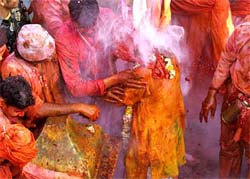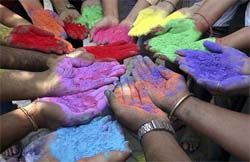| Holi |
 |
It is spring time in India, flowers and fields are in bloom and the country goes wild with people running on the streets and smearing each other with brightly hued powders and coloured water. This is the festival of Holi, celebrated on the day after the full moon in early March every year.
Originally Holi is a festival to celebrate good harvests and fertility of the land. There are many legends concerning the origin of this spring festival. The most popular among these concerns Prince Prahlad, the god-fearing son of the evil King Hiranyakasipu. Prahlad did not give up worshipping the god Vishnu in spite of fearful persecution by his father and his demon aunt Holika, who was deputed by her brother to kill young Prahlad. Ultimately, when Holika who was immune to death by fire, took Prahlad and entered a blazing furnace built for his destruction, it was the wicked Holika who was burnt to ashes by divine intervention, while Prahlad came out unscathed. Before she died, she realised her follies and begged the boy's forgiveness. As his gesture of forgiveness, Prahlad deemed that her name would be remembered at least one day in the year.
|
 |
Holi commemorates this event from mythology, and huge bonfires are burnt on the eve of Holi as its symbolic representation.
This exuberant festival is also associated with the immortal love of Krishna and Radha. The young Krishna would complain to his mother Yashoda about why Radha was so fair and he so dark. Yashoda advised him to apply colour on Radha's face and see how her complexion would change.
|
Holi is celebrated with particular eclat in the villages around Mathura, the birth-place of Krishna.
Down the ages, civilisation has advanced leaps and bounds, but the spirit of Holi remains the same. Each year, without fail, the old and the young alike, gather into groups and indulge in a riot of colours.
|
|
 |
Holi is also synonymous with bhang, which is consumed by many in the form of laddoos and ghols. One could get away with almost anything on this day; squirting coloured water on passers-by and dunking friends in the mud pool saying "bura na mano, Holi hai" (don't feel offended, it's Holi)'.
Apart from this usual fun with coloured powder and water, Holi is marked by vibrant
|
| processions which are accompanied by folk songs, dances and a general sense of abandoned vitality. |
|
|
|
| Religions |
In India, religion is a way of life. It is an integral part of the entire Indian tradition. For the majority of Indians, religion permeates every aspect of life, from common-place daily chores to education and politics. Secular India is home to Hinduism, Islam, Christianity, Buddhism, Jainism, Sikhism and other innumerable religious traditions. Hinduism is the dominant faith, practised by over 80% of the population. Besides Hindus, Muslims are the most prominent religious group and are an integral part of Indian society. In fact India has the second largest population of Muslims in the world after Indonesia.
|
| Read more about Indian Religions |
|
|
